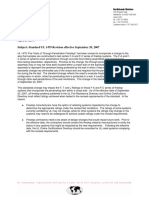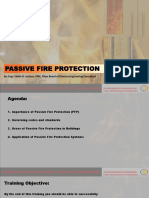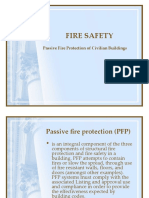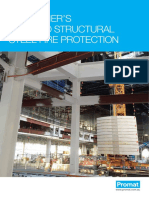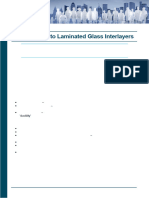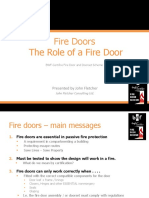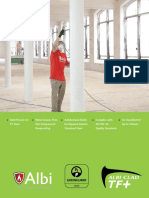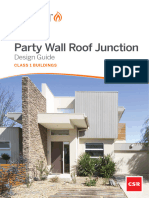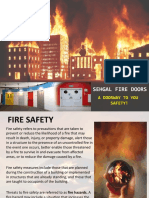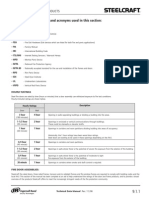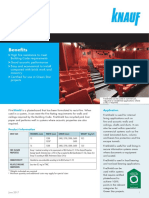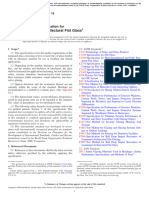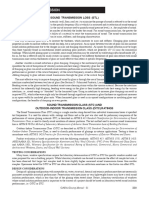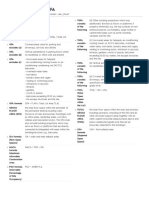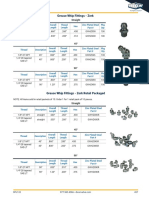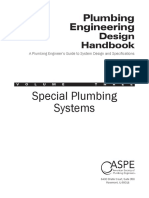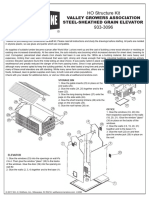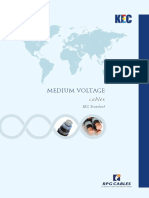Fire-Rated Glazing Products
Fire-Rated Glazing Products
Uploaded by
Kristoffer Jose AlcantaraCopyright:
Available Formats
Fire-Rated Glazing Products
Fire-Rated Glazing Products
Uploaded by
Kristoffer Jose AlcantaraCopyright
Available Formats
Share this document
Did you find this document useful?
Is this content inappropriate?
Copyright:
Available Formats
Fire-Rated Glazing Products
Fire-Rated Glazing Products
Uploaded by
Kristoffer Jose AlcantaraCopyright:
Available Formats
VIII.
FIRE-RATED GLAZING PRODUCTS
Fire-rated glazing materials are intended to help compartmentalize a fire in a building. A fire rating is determined by the length
of time a product can meet fire endurance testing to either fire-protective or fire-resistive standards. Fire-rated glazing materials
are tested to test standards and may not correlate to the building codes. Therefore, a fire-rating should not be confused with
approval for a particular application. The fire-protective or fire-resistive ratings mandated by most major U.S. Building Codes are
based on the application requirements. These requirements depend on how much time is necessary to maintain the structural
integrity of the building, and the safety and safe egress of its occupants.
Fire-rated glazing materials carry a label on the glass that may include the manufacturer, listed fire-rating and testing
agency.
There are a number of fire-rated products that will meet all the necessary fire-rated building code requirements. These
products are divided into fire-protective or fire-resistive categories.
Fire-Protective Glazing
This category includes polished wired glass, ceramics, specialty tempered glass, and specialty laminated or filmed glass (both
non-wired and wired). These products are generally between 1/4” and 5/8” thick. Fire ratings range from 20 minutes to 3 hours,
depending on the product and application. Consult your local building code official for appropriate use of protective glazing.
Wired Glass was the original fire-rated glass relying on embedded wires to hold the annealed glass together during a fire
endurance and hose stream test. Wired glass is required to meet the American National Standards Institute (ANSI) Z97.1
American National Standard for Safety Glazing Materials Used in Buildings - Safety Performance Specifications Method of Test
impact standard (100 ft.-lbs.). In fire-rated, hazardous locations identified in the model building codes, traditional wired glass
is limited to 9 sq. ft. In non-hazardous, fire-rated locations, traditional wired glass can be used up to the size tested and
approved. Wired glass has been developed for safety areas by some manufacturers that meet Consumer Product Safety Commission
(CPSC) 16 CFR 1201 Safety Standard for Architectural Glazing Materials Category I or Category II safety standards.
Ceramics withstand a fire endurance and hose stream test, and when laminated or filmed, can meet CPSC 16 CFR 1201 Cat
II (400 ft.-lbs.) safety requirements for use in hazardous locations. Fire-ratings range from 20 to 180 minutes depending on
application. Consult your local building code official for appropriate use of protective glazing.
Specialty Monolithic Tempered Glass, clear tempered glass with ratings of 20 minutes, listed for CPSC 16 CFR 1201
Category II (400 ft.-lbs.) safety for use in door locations.
Laminated Non-Wired Glass uses two pieces of annealed float glass laminated together with a fire protective interlayer. This
product meets CPSC 16 CFR 1201 Category I (150 ft.-lbs.) safety requirements and carries a 20 minute fire rating with 9 sq. ft.
size limitations in door locations.
Fire Protective Product Notes - Some of the above products provide improved acoustical, energy performance or radiant heat
transfer characteristics depending on the product selected. Contact the fire-rated glazing supplier for details on these enhanced
performance characteristics.
Key Questions to Ask in Selecting Fire-Protective Glazing Products
1) What is the minimum fire-rating required for this application?
2) Is an impact safety rating required?
3) Are there size limitations placed on the usage of a product based on code requirements?
Fire-Resistant Glazing
This category includes intumescent multi-laminate and gel-filled units. These clear, transparent products contain flames, the
spread of smoke and prevent the transfer of radiant heat for 60 minutes to 2 hours. These products are listed by third party testing
agencies as transparent walls and are therefore not limited to the 25% glazed area restriction, when used in a temperature rise
framing system of equal rating to the glazing.
Intumescent multi-laminate – these products utilize multiple sheets of annealed glass laminated together using special intumescent
interlayers. The number of interlayers and overall thickness determine the fire rating. Under fire conditions the interlayers
become opaque and expand to prevent the transmission of heat, smoke and flames.
GANA Glazing Manual - 53 2004
Gel-filled – these units resemble insulating glass units, however the cavity is filled with clear gel. The thickness of the gel cavity
determines the fire rating. Under fire conditions the gel crystallizes into an opaque heat absorbing char that prevents the
transmission of heat, smoke and flames.
Fire-Resistive Product Notes - Intumescent multi-laminate and gel-filled products provide improved acoustical performance and
are available for exterior use with energy saving make-ups. They can also be provided in special make-ups for bullet, blast,
hurricane, attack resistance, and other custom protections. Contact the fire-rated glazing supplier for details on these enhanced
performance characteristics.
Key Questions to Ask in Selecting a Fire-Resistive Glazing Product
1) What is the minimum fire-rating required for this application?
2) Is the framing capable of meeting the fire-resistive rating of the glazing?
3) What are the size limitations of the selected fire-resistive glazing?
4) Is the application exterior or interior?
5) Will the labeled framing meet the glazing thickness requirements for the selected fire-resistive rating?
DEFINITIONS
Fire-Protection Rating – The period of time that an opening protective assembly will maintain the ability to confine a fire as
determined by tests – NFPA 252 Standard Methods of fire Tests of Door Assemblies / NFPA 257 Standard on Fire Test for Window
and Glass Block Assemblies /UL 9 Standard for Fire Tests of Window Assemblies /UL 10c Standard for Positive Pressure Fire
Tests of Door Assemblies /ASTM E 2010 Standard Test Method for Positive Pressure Fire Tests of Window Assemblies /ASTM E
2074 Standard Test Method for Fire Tests of Door Assemblies, Including Positive Pressure Testing of Side-Hinged and Pivoted
Swinging Door Assemblies.
Fire-Resistance – That property of materials or their assemblies that prevents or retards the passage of excessive heat, hot
gases or flames under conditions of use.
Fire-Resistance Rating – The period of time a building element, component or assembly maintains the ability to confine a fire,
continues to perform a given structural function, or both, as determined by tests – NFPA 251 Standard Methods of Tests of
Fire Endurance of Building Construction and Materials/ASTM E 119 Standard Test Methods for Fire Tests of Building
Construction and Materials/UL 263 Standard for Fire Tests of Building Construction and Materials (wall assemblies).
GANA Glazing Manual - 54 2004
GANA Glazing Manual - 55 2004
You might also like
- Botond Bognar-Material Immaterial - The New Work of Kengo Kuma 2009Document256 pagesBotond Bognar-Material Immaterial - The New Work of Kengo Kuma 2009Yvette ChenNo ratings yet
- UL 1479 Handout PDFDocument2 pagesUL 1479 Handout PDFnaser71250% (2)
- Fire Tests of Roof Coverings: Standard Test Methods ForDocument13 pagesFire Tests of Roof Coverings: Standard Test Methods ForNada KhlifNo ratings yet
- BCMS Information Note 1-2018 Guidance On Timber Frame WallsDocument5 pagesBCMS Information Note 1-2018 Guidance On Timber Frame WallsLiam MinogueNo ratings yet
- Fire Test DefinitionDocument5 pagesFire Test DefinitionAnonymous 66UiCUHG4No ratings yet
- Passive Fire ProtectionDocument28 pagesPassive Fire ProtectionBFP PANGLAONo ratings yet
- SDI - 118 - Standard Steel Doors and FramesDocument9 pagesSDI - 118 - Standard Steel Doors and FramesPangit Bert100% (1)
- Fire Classif & ChecklistDocument8 pagesFire Classif & ChecklistAtulNo ratings yet
- Passive Fire Protection PDFDocument7 pagesPassive Fire Protection PDFVictor SampaNo ratings yet
- Open Inviting and Safe - Designing Secure Buildings PDFDocument4 pagesOpen Inviting and Safe - Designing Secure Buildings PDFArighna MitraNo ratings yet
- Fire Safety: Passive Fire Protection of Civilian BuildingsDocument21 pagesFire Safety: Passive Fire Protection of Civilian BuildingsEmilian BuduganNo ratings yet
- 25 - 24 06 14 - A5 Guide 05 14 WebDocument104 pages25 - 24 06 14 - A5 Guide 05 14 WebnextomegagenNo ratings yet
- B.S. Group DDocument25 pagesB.S. Group DSaniya SiddiquiNo ratings yet
- Specification GPX Curtain Wall Framing Part 1 General: Section 08 8810: Fire Rated Glass & FramingDocument6 pagesSpecification GPX Curtain Wall Framing Part 1 General: Section 08 8810: Fire Rated Glass & Framingmaris_sasecNo ratings yet
- Specs PyrostopDocument7 pagesSpecs PyrostopfakemasterkgpNo ratings yet
- Fire Rated Doors 09th Feb 2024Document18 pagesFire Rated Doors 09th Feb 2024Nitin KumarNo ratings yet
- Epoxy Intumescent Coating Systems For The Corrosion Protection and Fire Protection of Structural Steel IfjDocument4 pagesEpoxy Intumescent Coating Systems For The Corrosion Protection and Fire Protection of Structural Steel IfjAnonymous B7pghhNo ratings yet
- Build TechDocument4 pagesBuild Techahmad nadzriNo ratings yet
- Meeting The Fire Code With Continuous Foam Plastic Insulation 43 D100637 enUSDocument4 pagesMeeting The Fire Code With Continuous Foam Plastic Insulation 43 D100637 enUSMohamed Osama AshmawyNo ratings yet
- By Arthur J. Parker, PE and Jesse J. Beitel: Modern MaterialsDocument3 pagesBy Arthur J. Parker, PE and Jesse J. Beitel: Modern MaterialsHaroun EdressNo ratings yet
- 1. wikipediaDocument6 pages1. wikipediaSalim BakhshNo ratings yet
- Appendix 1 - Guidance On Timber Frame WallsDocument5 pagesAppendix 1 - Guidance On Timber Frame WallsIsabel BarrosNo ratings yet
- What Is Fire StoppingDocument19 pagesWhat Is Fire StoppingJemond PagunsanNo ratings yet
- Introduction To Fr-Acp (Fire Retardant Aluminum Composite Panels)Document12 pagesIntroduction To Fr-Acp (Fire Retardant Aluminum Composite Panels)Syed RaziuddinNo ratings yet
- Specifiers Guide To Steel ProtectionDocument6 pagesSpecifiers Guide To Steel ProtectionKumararaja KonikkiNo ratings yet
- Passive Fire ProtectionDocument21 pagesPassive Fire ProtectionZulHilmi ZakariaNo ratings yet
- Npsa Intro To Laminated Glass InterlayersDocument8 pagesNpsa Intro To Laminated Glass Interlayersnelsonanderson023No ratings yet
- Handbook PFP Linear GB 1Document58 pagesHandbook PFP Linear GB 1Valentin A.No ratings yet
- Rainbow F2 Firecut CatalogueDocument1 pageRainbow F2 Firecut Cataloguevincent003721No ratings yet
- JF DoorsDocument49 pagesJF DoorsKarthikeyan PanchatcharamNo ratings yet
- Class 1 and Class A Roof AssembliesDocument3 pagesClass 1 and Class A Roof AssembliesdantranzNo ratings yet
- ALBI-TF-plus - Rev-GG-1 BrochureDocument4 pagesALBI-TF-plus - Rev-GG-1 BrochureeliasjosecNo ratings yet
- Fire Door Assembly Classifications: DecodedDocument3 pagesFire Door Assembly Classifications: DecodedTty SmithNo ratings yet
- Antifire PaintDocument2 pagesAntifire PaintAli ZaibNo ratings yet
- Fireseal Party Wall Design Guide For Class 1 BuildingsDocument16 pagesFireseal Party Wall Design Guide For Class 1 BuildingsnuazeaNo ratings yet
- S Rinkler D I Az NG Protection of Exterior: AbstruetDocument23 pagesS Rinkler D I Az NG Protection of Exterior: AbstruetShashikant ChaturvediNo ratings yet
- European Building CodeDocument2 pagesEuropean Building CodeArdrick BoscoNo ratings yet
- Passive Fire Protection SystemDocument33 pagesPassive Fire Protection Systemfayis u m100% (2)
- UK - EU Fire Test Case Studies PAGES LRDocument32 pagesUK - EU Fire Test Case Studies PAGES LRsundarNo ratings yet
- Fire Cabinet Basic SpecificationsDocument6 pagesFire Cabinet Basic SpecificationsYehia El ShinnawyNo ratings yet
- Is16947 2018Document20 pagesIs16947 2018Rajeev VijayanNo ratings yet
- 3M Fire Barrier Sealant CP 25WB+Document2 pages3M Fire Barrier Sealant CP 25WB+Reginald D. De GuzmanNo ratings yet
- Usg Area Separation Walls Catalog en SA925Document16 pagesUsg Area Separation Walls Catalog en SA925fire-1No ratings yet
- DC 315 Master SpecificationDocument6 pagesDC 315 Master SpecificationYusuf AhmedNo ratings yet
- Fire Doors in Compliance With NFPADocument32 pagesFire Doors in Compliance With NFPAHuzaifa SafdarNo ratings yet
- Fire-Rated Glass Document38Document5 pagesFire-Rated Glass Document38jefftemple0% (1)
- Lorient BrochureDocument28 pagesLorient BrochureJerry Lee LiongsonNo ratings yet
- Fire DoorDocument28 pagesFire DoorkaushikfreegmailcomNo ratings yet
- BS en 1154 - 1997 + A1 - 2003 Controlled-Door-Closing-DevicesDocument8 pagesBS en 1154 - 1997 + A1 - 2003 Controlled-Door-Closing-DevicesNitin KumarNo ratings yet
- A Guide To Fire Door PerformanceDocument32 pagesA Guide To Fire Door PerformancePaulNo ratings yet
- Fire SafeDocument18 pagesFire SafebakkakraljNo ratings yet
- Glossary of Abbreviations and Acronyms Used in This SectionDocument8 pagesGlossary of Abbreviations and Acronyms Used in This SectionurkirannandaNo ratings yet
- Passive Fire ProtectionDocument13 pagesPassive Fire ProtectionAzmi SuhardiNo ratings yet
- Knauf Gypsum Board FireShield Technical DataDocument2 pagesKnauf Gypsum Board FireShield Technical Dataricky permanaNo ratings yet
- FireproofingDocument3 pagesFireproofingarki_emmanNo ratings yet
- ASTM C 1172-19 - Standard Specification For Laminated Architectural Flat GlassDocument6 pagesASTM C 1172-19 - Standard Specification For Laminated Architectural Flat GlassDJ JM100% (1)
- Ficha Tecnica - Microseal - DSDocument2 pagesFicha Tecnica - Microseal - DSedocducNo ratings yet
- 078100-Spray-Applied-Fireproofing-Specification - Monokote MK-6Document7 pages078100-Spray-Applied-Fireproofing-Specification - Monokote MK-6Ralph Ian MalabananNo ratings yet
- RD GlazingDocument21 pagesRD Glazings_omeone4usNo ratings yet
- Residential Asphalt Roofing Manual Design and Application Methods 2014 EditionFrom EverandResidential Asphalt Roofing Manual Design and Application Methods 2014 EditionNo ratings yet
- Your Home Inspected: An Addendum for Residential Home Inspection ReportsFrom EverandYour Home Inspected: An Addendum for Residential Home Inspection ReportsNo ratings yet
- 99a - Appendix OneDocument4 pages99a - Appendix OneKristoffer Jose AlcantaraNo ratings yet
- GlossaryDocument12 pagesGlossaryKristoffer Jose AlcantaraNo ratings yet
- LabelingDocument1 pageLabelingKristoffer Jose AlcantaraNo ratings yet
- Design ConsiderationsDocument15 pagesDesign ConsiderationsKristoffer Jose AlcantaraNo ratings yet
- Primary Glass ProductsDocument2 pagesPrimary Glass ProductsKristoffer Jose AlcantaraNo ratings yet
- Sound TransmissionDocument2 pagesSound TransmissionKristoffer Jose AlcantaraNo ratings yet
- Specific Guidelines For GlazingDocument26 pagesSpecific Guidelines For GlazingKristoffer Jose AlcantaraNo ratings yet
- Smrco Wind Load Annex ADocument1 pageSmrco Wind Load Annex AKristoffer Jose AlcantaraNo ratings yet
- Guide To Installation of Steel Windows: Sealing The JointDocument6 pagesGuide To Installation of Steel Windows: Sealing The JointKristoffer Jose AlcantaraNo ratings yet
- FRA Safety Standards vs. General InspectionDocument72 pagesFRA Safety Standards vs. General InspectionRocio Mayta JaquehuaNo ratings yet
- Construction Technology .KDocument247 pagesConstruction Technology .KHarshit Kumar SahuNo ratings yet
- Catalogue Ebara SQPBDocument6 pagesCatalogue Ebara SQPBFeb OktafihartoNo ratings yet
- PD 1096 - Basic LawDocument1 pagePD 1096 - Basic Lawhannah marvillaNo ratings yet
- Title of The Project: 3.2.1 RainfallDocument17 pagesTitle of The Project: 3.2.1 RainfallMo Rayyan Panandigan SaidNo ratings yet
- Chapter12 Geotechnical2020Document211 pagesChapter12 Geotechnical2020Frank Xiu100% (1)
- Graseras DixonDocument1 pageGraseras DixonNoel BermudezNo ratings yet
- Pressure Plate MaterialDocument5 pagesPressure Plate MaterialBhavani Prasad100% (1)
- 2.DCDU Power Connection Standard and Inspection Key Points - PPTX (2.42MB) ...Document10 pages2.DCDU Power Connection Standard and Inspection Key Points - PPTX (2.42MB) ...JULIÁN TRUJILLONo ratings yet
- Refrigerant RecoveryDocument2 pagesRefrigerant RecoverykapilchandsinghalNo ratings yet
- Plumbing Engineering Design Handbook Volume 3 Special Plumbing SystemsDocument366 pagesPlumbing Engineering Design Handbook Volume 3 Special Plumbing SystemsWahid Husain100% (1)
- Doctor RoomDocument1 pageDoctor Roomabe.kenway001No ratings yet
- Section 5 Construction PhilosophyDocument11 pagesSection 5 Construction Philosophyjeya vasanthNo ratings yet
- Construction Aggrement EnglishDocument7 pagesConstruction Aggrement Englishcivilaravind mNo ratings yet
- Pile Top Drill Rigs - en 1Document16 pagesPile Top Drill Rigs - en 1aminoNo ratings yet
- Kajian Model Fisik Pengaruh Freeboard Da 81bcbe6eDocument10 pagesKajian Model Fisik Pengaruh Freeboard Da 81bcbe6ehanaNo ratings yet
- HO Structure Kit 933-3096: Valley Growers Association Steel-Sheathed Grain ElevatorDocument2 pagesHO Structure Kit 933-3096: Valley Growers Association Steel-Sheathed Grain ElevatorJavier Hidalgo SanchezNo ratings yet
- BSP025 Business Environment Analysis AssessmentDocument2 pagesBSP025 Business Environment Analysis AssessmentMuhammad SaalimNo ratings yet
- The Principles of Housing Layout DesignDocument21 pagesThe Principles of Housing Layout DesignamirolNo ratings yet
- Exrusion 1Document41 pagesExrusion 1UsMan ZaFarNo ratings yet
- Medium Voltage CatalogueDocument62 pagesMedium Voltage CatalogueAshutosh SharmaNo ratings yet
- Injection MoldingDocument17 pagesInjection MoldingAnoj pahathkumburaNo ratings yet
- 14 Kitchen Design GuidelineDocument72 pages14 Kitchen Design GuidelineventosNo ratings yet
- Mod ExpDocument8 pagesMod ExpwalidNo ratings yet
- Const Method DrainageDocument2 pagesConst Method DrainageNeil Mark Solarte UndagNo ratings yet
- Pip PNSMV006Document22 pagesPip PNSMV006Saure GnuNo ratings yet
- Hdpe SystemDocument93 pagesHdpe Systemrommel duranNo ratings yet
- Diamco Centrifugal RFQ - 18-Rb-Rev0Document2 pagesDiamco Centrifugal RFQ - 18-Rb-Rev0sakarisoNo ratings yet
- Nordic Tug 44 SpecificationsDocument3 pagesNordic Tug 44 SpecificationsWilde YachtsNo ratings yet

